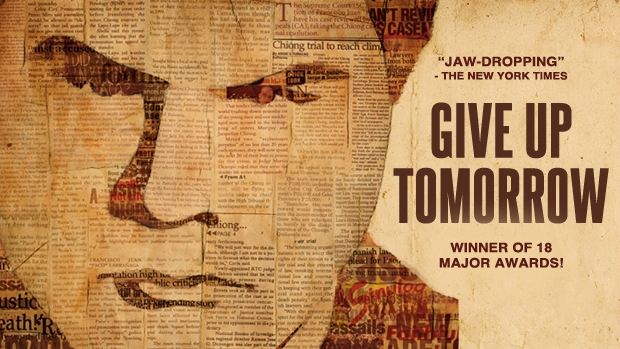Resources: Give Up Tomorrow
As a tropical storm beats down on the Philippine island of Cebu, two sisters leave work and never make it home. That same night, hundreds of miles away in Manila on a different island, Paco Larrañaga, 19, is at a party, surrounded by dozens of reliable witnesses. The missing women are pretty and innocent Chinese-Filipinos, a group that has formed a traditional underclass. Paco, accused of their rapes and murders, is part of a prominent mestizo political clan that includes a former president. Beefy and tough, with a past of petty offenses, he neatly fits the role of privileged thug – and that is how he is cast by a frenzied media circus that swarms his arrest and trial, and cheers his eventual sentence to death by lethal injection. Reflecting schisms of race, class, and political power at the core of the Philippines’ tumultuous democracy, clashing families, institutions, and individuals face off to convict or free Paco. Their irreconcilable versions of reality and justice play out in a case that ends a country’s use of capital punishment, yet fails to free an innocent man.
Give Up Tomorrow is not your usual suspense story of a man wrongly accused, and Paco Larrañaga is not your usual hero. But his very lack of facile appeal challenges his society and filmgoers to rely on facts over impressions, evidence over prejudice.
Amnesty International, the government of Spain, Fair Trials International, and the United Nations are unequivocal in the belief that for more than a decade, Paco has been paying with his freedom for a crime he did not commit. Indeed, some 40 people including classmates and teachers from the culinary school he attends – along with photographic evidence – place him hundreds of miles from the grim crime scene.
Rather than simply building an evidentiary case about an individual injustice, the film exposes the roots of this miscarriage to reveal the interconnected complexities that permeate Filipino culture. Unlike the court that Paco faces, Give Up Tomorrow gives a fair trial to the forces and institutions that arbitrate justice with a mix of capriciousness and malice. In a way that is both specific to the Philippines and disquietingly universal, the film exposes a Kafkaesque extravaganza populated by flamboyantly corrupt public officials, drug dealers, cops on the take, and journalists in thrall to and in lonely stance against, a frenzied legal and media circus. It is also an intimate family drama focused on the near mythic struggle of two angry and sorrowful mothers who have dedicated more than a decade to executing or saving one young man.
Lesson plans
Video Clips
-
 Clip: 10. The fight for freedom continues
Paco remains in Spanish prison. Paco, his family and the legal team vow to fight on and clear his name
Clip: 10. The fight for freedom continues
Paco remains in Spanish prison. Paco, his family and the legal team vow to fight on and clear his name -
 Clip: 1. Introducing Paco
We meet Paco Larrañaga and are introduced to his case
Clip: 1. Introducing Paco
We meet Paco Larrañaga and are introduced to his case -
 Clip: 2. Re-enactment of the crime
A re-enactment of the crime was produced and televised nationally during the trial. Paco's school friends take to the stand
Clip: 2. Re-enactment of the crime
A re-enactment of the crime was produced and televised nationally during the trial. Paco's school friends take to the stand -
 Clip: 3. Verdict: two years after the arrest
The end of Paco's trial gives a shocking result.
Clip: 3. Verdict: two years after the arrest
The end of Paco's trial gives a shocking result.
-
 Clip: 4. What happened to everyone after the trial?
What happened to the Prosecution, the Judge and Paco after the verdict?
Clip: 4. What happened to everyone after the trial?
What happened to the Prosecution, the Judge and Paco after the verdict? -
 Clip: 5. Paco in jail and a new president takes office
A sentence is declared. We learn more about the political context of Paco's incarceration
Clip: 5. Paco in jail and a new president takes office
A sentence is declared. We learn more about the political context of Paco's incarceration -
 Clip: 6. Appeals to the Spanish Court and the Media
Paco's team appeal to the Supreme Court. The international community get involved
Clip: 6. Appeals to the Spanish Court and the Media
Paco's team appeal to the Supreme Court. The international community get involved -
 Clip: 7. UN Human Rights Committee takes on the case
The Spanish defense minister discusses the case with the president of the Phillipines
Clip: 7. UN Human Rights Committee takes on the case
The Spanish defense minister discusses the case with the president of the Phillipines
-
 Clip: 8. Paco's family visit the jail
Eating and dancing: Paco's parents visit him in prison.
Clip: 8. Paco's family visit the jail
Eating and dancing: Paco's parents visit him in prison. -
 Clip: 9. Paco is transferred to a Spanish Prison
Paco leaves the Philippines, headed for a Spanish prison. Is this progress?
Clip: 9. Paco is transferred to a Spanish Prison
Paco leaves the Philippines, headed for a Spanish prison. Is this progress?






